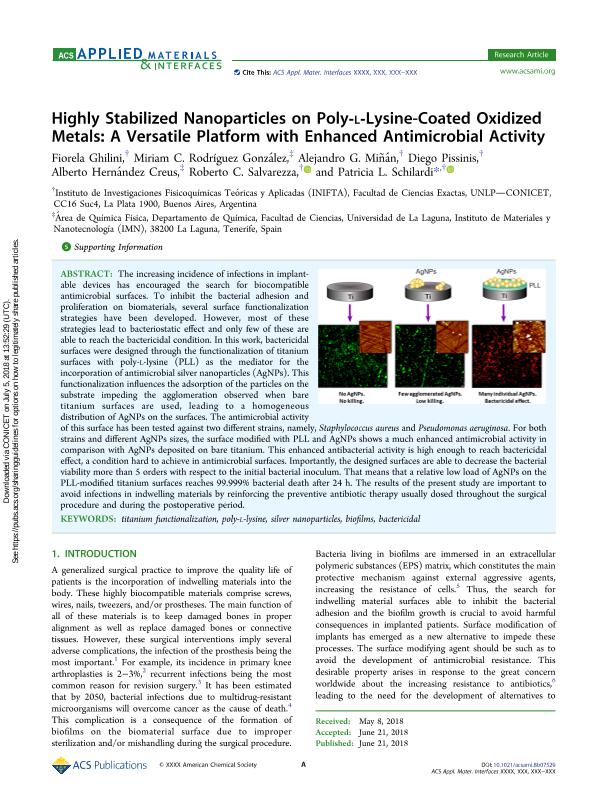Mostrar el registro sencillo del ítem
dc.contributor.author
Ghilini, Fiorela

dc.contributor.author
Rodríguez González, Miriam C.
dc.contributor.author
Miñan, Alejandro Guillermo

dc.contributor.author
Pissinis, Diego Ezequiel

dc.contributor.author
Creus, Alberto Hernández
dc.contributor.author
Salvarezza, Roberto Carlos

dc.contributor.author
Schilardi, Patricia Laura

dc.date.available
2020-04-07T16:55:09Z
dc.date.issued
2018-07
dc.identifier.citation
Ghilini, Fiorela; Rodríguez González, Miriam C.; Miñan, Alejandro Guillermo; Pissinis, Diego Ezequiel; Creus, Alberto Hernández; et al.; Highly Stabilized Nanoparticles on Poly- l -Lysine-Coated Oxidized Metals: A Versatile Platform with Enhanced Antimicrobial Activity; American Chemical Society; ACS Applied Materials & Interfaces; 10; 28; 7-2018; 23657-23666
dc.identifier.issn
1944-8244
dc.identifier.uri
http://hdl.handle.net/11336/102171
dc.description.abstract
The increasing incidence of infections in implantable devices has encouraged the search for biocompatible antimicrobial surfaces. To inhibit the bacterial adhesion and proliferation on biomaterials, several surface functionalization strategies have been developed. However, most of these strategies lead to bacteriostatic effect and only few of these are able to reach the bactericidal condition. In this work, bactericidal surfaces were designed through the functionalization of titanium surfaces with poly-l-lysine (PLL) as the mediator for the incorporation of antimicrobial silver nanoparticles (AgNPs). This functionalization influences the adsorption of the particles on the substrate impeding the agglomeration observed when bare titanium surfaces are used, leading to a homogeneous distribution of AgNPs on the surfaces. The antimicrobial activity of this surface has been tested against two different strains, namely, Staphylococcus aureus and Pseudomonas aeruginosa. For both strains and different AgNPs sizes, the surface modified with PLL and AgNPs shows a much enhanced antimicrobial activity in comparison with AgNPs deposited on bare titanium. This enhanced antibacterial activity is high enough to reach bactericidal effect, a condition hard to achieve in antimicrobial surfaces. Importantly, the designed surfaces are able to decrease the bacterial viability more than 5 orders with respect to the initial bacterial inoculum. That means that a relative low load of AgNPs on the PLL-modified titanium surfaces reaches 99.999% bacterial death after 24 h. The results of the present study are important to avoid infections in indwelling materials by reinforcing the preventive antibiotic therapy usually dosed throughout the surgical procedure and during the postoperative period.
dc.format
application/pdf
dc.language.iso
eng
dc.publisher
American Chemical Society

dc.rights
info:eu-repo/semantics/openAccess
dc.rights.uri
https://creativecommons.org/licenses/by-nc-sa/2.5/ar/
dc.subject
SILVER NANOPARTICLES
dc.subject
POLY-L-LYSINE
dc.subject
BACTERICIDAL
dc.subject
TITANIUM
dc.subject.classification
Biología Celular, Microbiología

dc.subject.classification
Ciencias Biológicas

dc.subject.classification
CIENCIAS NATURALES Y EXACTAS

dc.subject.classification
Otras Nanotecnología

dc.subject.classification
Nanotecnología

dc.subject.classification
INGENIERÍAS Y TECNOLOGÍAS

dc.title
Highly Stabilized Nanoparticles on Poly- l -Lysine-Coated Oxidized Metals: A Versatile Platform with Enhanced Antimicrobial Activity
dc.type
info:eu-repo/semantics/article
dc.type
info:ar-repo/semantics/artículo
dc.type
info:eu-repo/semantics/publishedVersion
dc.date.updated
2020-04-02T15:15:30Z
dc.journal.volume
10
dc.journal.number
28
dc.journal.pagination
23657-23666
dc.journal.pais
Estados Unidos

dc.description.fil
Fil: Ghilini, Fiorela. Consejo Nacional de Investigaciones Científicas y Técnicas. Centro Científico Tecnológico Conicet - La Plata. Instituto de Investigaciones Fisicoquímicas Teóricas y Aplicadas. Universidad Nacional de La Plata. Facultad de Ciencias Exactas. Instituto de Investigaciones Fisicoquímicas Teóricas y Aplicadas; Argentina
dc.description.fil
Fil: Rodríguez González, Miriam C.. Universidad de La Laguna; España
dc.description.fil
Fil: Miñan, Alejandro Guillermo. Consejo Nacional de Investigaciones Científicas y Técnicas. Centro Científico Tecnológico Conicet - La Plata. Instituto de Investigaciones Fisicoquímicas Teóricas y Aplicadas. Universidad Nacional de La Plata. Facultad de Ciencias Exactas. Instituto de Investigaciones Fisicoquímicas Teóricas y Aplicadas; Argentina
dc.description.fil
Fil: Pissinis, Diego Ezequiel. Consejo Nacional de Investigaciones Científicas y Técnicas. Centro Científico Tecnológico Conicet - La Plata. Instituto de Investigaciones Fisicoquímicas Teóricas y Aplicadas. Universidad Nacional de La Plata. Facultad de Ciencias Exactas. Instituto de Investigaciones Fisicoquímicas Teóricas y Aplicadas; Argentina
dc.description.fil
Fil: Creus, Alberto Hernández. Universidad de La Laguna; España
dc.description.fil
Fil: Salvarezza, Roberto Carlos. Consejo Nacional de Investigaciones Científicas y Técnicas. Centro Científico Tecnológico Conicet - La Plata. Instituto de Investigaciones Fisicoquímicas Teóricas y Aplicadas. Universidad Nacional de La Plata. Facultad de Ciencias Exactas. Instituto de Investigaciones Fisicoquímicas Teóricas y Aplicadas; Argentina
dc.description.fil
Fil: Schilardi, Patricia Laura. Consejo Nacional de Investigaciones Científicas y Técnicas. Centro Científico Tecnológico Conicet - La Plata. Instituto de Investigaciones Fisicoquímicas Teóricas y Aplicadas. Universidad Nacional de La Plata. Facultad de Ciencias Exactas. Instituto de Investigaciones Fisicoquímicas Teóricas y Aplicadas; Argentina
dc.journal.title
ACS Applied Materials & Interfaces

dc.relation.alternativeid
info:eu-repo/semantics/altIdentifier/url/https://pubs.acs.org/doi/10.1021/acsami.8b07529
dc.relation.alternativeid
info:eu-repo/semantics/altIdentifier/doi/http://dx.doi.org/10.1021/acsami.8b07529
Archivos asociados
